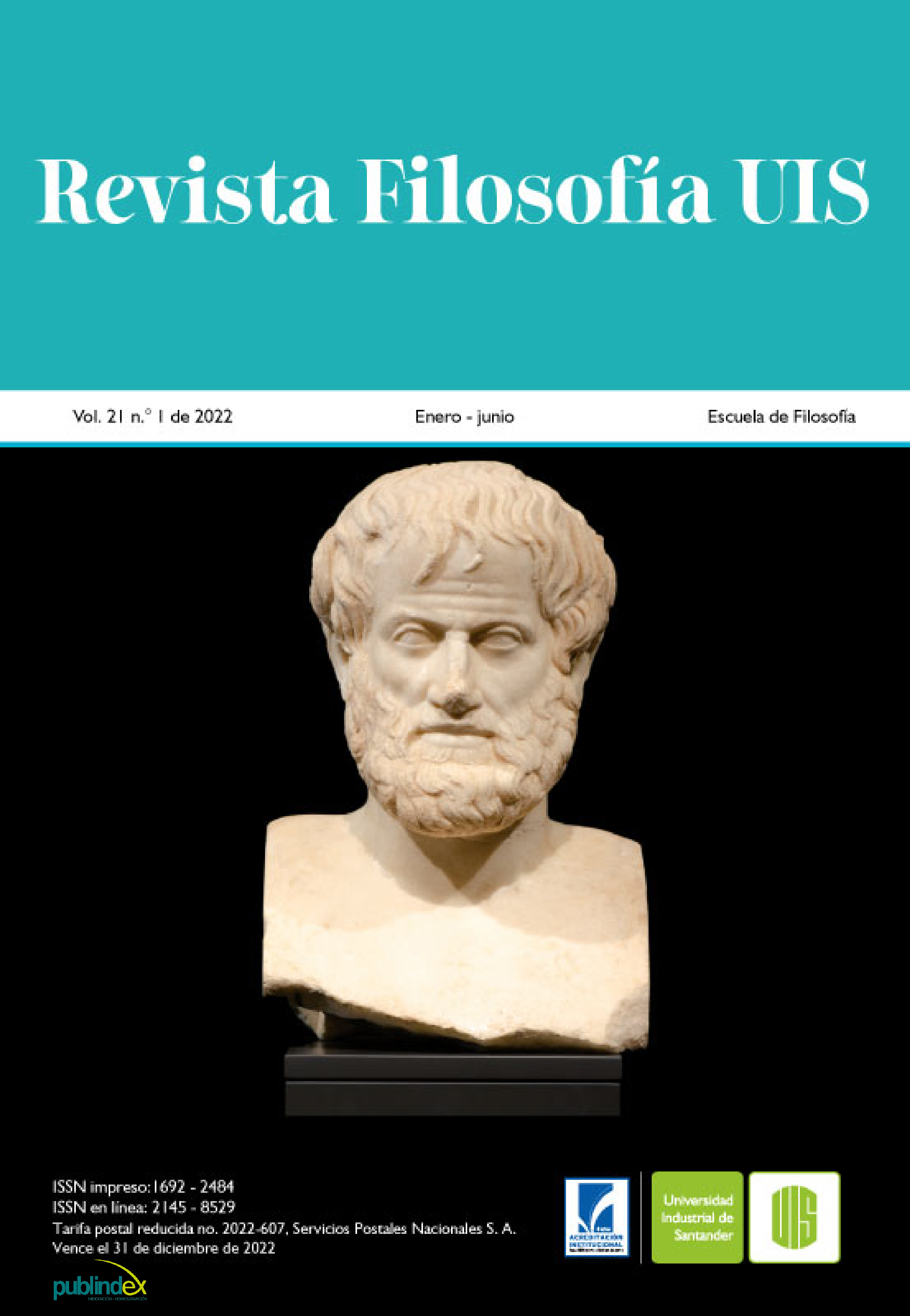Possibilities of a Physicalist Interpretation of Consciousness. Some Clarifying Ideas
Published 2022-01-03
Keywords
- consciousness,
- reduction-elimination,
- first-third person,
- ontology-epistemology,
- common sense
- neuroscience ...More
How to Cite
Copyright (c) 2022 Revista Filosofía UIS

This work is licensed under a Creative Commons Attribution 4.0 International License.
Abstract
in this text we evaluate the conceptual possibilities of a physicalist interpretation of consciousness. To this end, representative physicalist positions in the field of philosophy as well as recent neuroscientific research are taken into account. Both lines of research involve questioning common sense approaches to the issue of consciousness. However, they do not imply a complete elimination of what this approach can represent. In this sense, an epistemological interpretation of the first person perspective is presented in relation with a third person, scientific perspective.
Downloads
References
- Blackmore, S. (2005). Conversations on Consciousness. Oxford University press.
- Blanco, D. (2000). El Movimiento Fenomenológico. En J. Muguerza y P. Cerezo, (Eds.), La Filosofía Hoy (pp. 65-75). Crítica.
- Braun. R. (2008). El eliminativismo filosófico y su ataque a la psicología. Persona, (011), 51-67. https://doi.org/10.26439/persona2008.n011.923
- Chalmers, D. (1995). The Conscious Mind: In Search of a Fundamental Theory. Oxford University Press.
- Chalmers, D. (1998). On the Search for Neural Correlate of Consciousness. En A. Hameroff, A. Kaszniak & A. Scott (Eds.), Toward a Science of Consciousness II: The First Tucson Discussions and Debates. MIT Press.
- Chalmers, D. (2000). What is a Neural Correlate of Consciousness? En T. Metzinger (Ed.), Neural Correlates of Consciousness: Empirical and Conceptual Issues. MIT Press.
- Chariker, L. Shapley R. & Young L-S. (2016). Orientation Selectivity from Very Sparse LGN Inputs in a Comprehensive Model of Macaque V1 Cortex. Journal of Neuroscience, 36(49), 12368-12384. https://doi.org/10.1523/JNEUROSCI.2603-16.2016
- Churchland, P. S. (1983). Consciousness: The Transmutation of a Concept. Pacific Philosophical Quarterly, 64, 80-95. https://doi.org/10.1111/j.1468-0114.1983.tb00186.x
- Churchland, P. S. (1988). Neurophilosophy. Toward a Unified Theory of the Mind/Brain. MIT Press.
- Churchland, P. (1995). El materialismo eliminativo y las actitudes proposicionales. En E, Rabossi (Ed.), Filosofía de la mente y ciencia cognitiva (pp. 43-68). Paidós.
- Churchland, P. (1999). Materia y Conciencia. Introducción Contemporánea a la Filosofía de la Mente. Gedisa.
- Churchland, P. (2007). The Evolving Fortunes of Eliminative Materialism. En B. McLaughlin & J. Cohen (Eds.), Contemporary Debates in Philosophy of Mind. (pp. 160-182). Blackwelll Publishing.
- Dehaene, S. (2014). Consciousness and the Brain. Deciphering How the Brain Codes Our Thoughts. Penguin Random House.
- Dennett, D. (1991). Consciousness Explained. Back Bay Books.
- Dennett, D. (1998). La Actitud Intencional. Gedisa.
- Dennett, D. (2017). De las bacterias a Bach. La evolución de la mente. (M. Figueras, trad.). Pasado y Presente.
- Descartes, R. (2002). Meditations on First Philosophy (II and IV). En D. Chalmers (Ed.), Philosophy of Mind, Classical and Contemporary Readings (pp. 10-21). Oxford University Press.
- Díez, J. A. y Moulines, C. U. (1997). Fundamentos de Filosofía de la Ciencia. Ariel.
- Dupré, J. (2001). Human Nature and the Limits of Science. Oxford University Press.
- Esparza-Oviedo, S. M. (2020). Similitudes y diferencias en la conceptualización de la conciencia ofrecida por el materialismo eliminativo y el funcionalismo. Un análisis crítico. Revista Filosofía UIS, 19(1), 203-228. https://doi.org/10.18273/revfil.v19n1-2020007
- Gabriel, M. (2016). Yo no soy mi cerebro. Filosofía de la mente para el siglo XXI. Pasado y Presente.
- Gallaguer, S. & Zahavi, D. (2014). La Mente Fenomenológica (M. Jorba, trad.). Alianza Editorial.
- Gazzaniga, M. S. (2000). Cerebral specialization and interhemispheric communication. Does the corpus callosum enable the human condition? Brain, 123(7), 1293-1326. https://doi.org/10.1093/brain/123.7.1293
- Harari, Y. N. (2016). Homo Deus. Breve historia del mañana. (J. Ros, trad.). Debate. Hurvich, L. M. & Jameson, D. (1957). An Opponent-Process Theory of Color Vision. Psychological Review, 64(6), 384-404. https://psycnet.apa.org/doi/10.1037/h0041403
- Jackson, F. (1982). Epiphenomenal Qualia. The Philosophical Quarterly, 32(127), 127-136. https://doi.org/10.2307/2960077
- James, W. (2016). Pragmatismo. (R. del Castillo, trad.). Alianza Editorial.
- Kim, J. (1998). Mind in a Physical World. An Essay on the Mind-Body Problem and Mental Causation. MIT Press.
- Kind, A. (2014). The Case Against Representation about Moods and Emotions. En U. Kriegel (Ed.), Current Controversies in Philosophy of Mind (pp. 113-134). Routledge.
- Koch, Cc. & Tsuchiya (2007). Attention and Consciousness: Two Distinct Brain Processes. Trends in Cognitive Sciences, 11(1), 16-22. https://doi.org/10.1016/j.tics.2006.10.012
- LeDoux, J. E., Wilson, D. H. y Gazzaniga, M. S. (1977). A Divided Mind: Observations on the Conscious Properties of Separated Hemispheres. Ann Neurol, 2, 417-421. https://doi.org/10.1002/ana.410020513
- Llácer, T. (2015). Nietzsche. El Superhombre y la Voluntad de Poder. Batiscafo.
- McFadden, J. (2020). Integrating information in the brain´s EM field: the cemi field theory of conciousness. Neuroscience of Consciousness, 6(1). https://doi.org/10.1093/nc/niaa016
- Mosterín, J. (2008). Conceptos y Teorías en la Ciencia. Alianza Editorial.
- Moya, C. J. (2006). Filosofía de la Mente. Universitat de Valencia.
- Nagel, T. (1974) What is Like to be a Bat? The Philosophical Review, 83(4), 435-450. https://www.jstor.org/stable/2183914?origin=JSTOR-pdf
- Pinker, S. (1998). How the Mind Works. Penguin Random House.
- Ramsey, W. (2019). Eliminative Materialism. En E. Zalta (Ed.), The Stanford Encyclopedia of Philosophy (Spring 2019 Edition). https://plato.stanford.edu/archives/spr2019/entries/materialism-eliminative
- Rovelli, C. (2006). The Disappearance of Space and Time. En Dieks, D. (Ed.), The Ontology of Space Time (pp. 25-36). Elsevier.
- Seager, W. (2016). Theories of Consciousness. An Introduction and Assessment. Routledge.
- Sperry, W., Gazzaniga, M. S. y Bogen, J. E. (1969). Interhemispheric relationships: the neocortical commissures; syndromes of hemisphere disconnection. Handbook of Clinical Neurology, 4, 273-290. https://resolver.caltech.edu/CaltechAUTHORS:20170414-111911293
- Van Riel, R. & Van Gulick, R. (2019). Scientific Reduction. En E. Zalta (Ed.), The Stanford Encyclopedia of Philosophy (Spring 2019 Edition). https://plato.stanford.edu/archives/spr2019/entries/scientific-reduction/
- Wittgenstein, L. (2012). Investigaciones Filosóficas. Crítica.

